At meeting on guardrails for gene editing of human embryos, some call for a dead end
By Megan Molteni,
Stat
| 03. 28. 2025
WASHINGTON — Keith Joung knows better than a lot of people what, exactly, it might require to prove to regulators and patients that CRISPR could be safely used to alter the genome of a human embryo. If, of course, society decided that was a good idea. Joung, an early pioneer of the gene-editing technology, was the first to show CRISPR could target and cut DNA inside an embryo — in zebrafish — back in 2013.
Not long after, his group was among the earliest to discover that CRISPR could get a bit sloppy — inadvertently slicing up unintended regions of the genome in all sorts of cells — complicating hopes it might be used to cure illnesses from cancer to muscular dystrophy. A pathologist by training, Joung has spent much of the intervening decade designing ever-more sensitive methods for detecting these so-called off-target effects and finding ways to minimize the chances they occur.
Such methods have, in the last two years, proved pivotal in the decisions by regulators to approve the first CRISPR-based medicine — an infusion of gene-edited blood...
Related Articles
By Katrina Northrop, The Washington Post | 04.06.2025
photo via Wikimedia Commons licensed under CC by 3.0
China's most infamous scientist is attempting a comeback. He Jiankui, who went to jail for three years after claiming he had created the world's first genetically altered babies, says he remains...
By Kevin Davies, Genetic Engineering & Biotechnology News | 03.27.2025
Around 2018–19, there was not a bigger science and ethical story than the debate over heritable human genome editing (HHGE) and the scandal over the “CRISPR babies.” The scientist, He Jiankui, who attempted to engineer the germline of human embryos...
By Liyan Qi and Jonathan Cheng, The Wall Street Journal | 03.26.2025
photo via Wikimedia Commons licensed under CC by 3.0
Chinese scientist He Jiankui set off global outrage and landed in prison after he skirted ethical guidelines and claimed he had produced genetically modified babies designed to resist HIV infection.
Now, the self-styled ...
By Anna Louie Sussman, The New York Times | 03.25.2025
On June 24, 2022, the same day the Supreme Court issued its decision in Dobbs v. Jackson Women’s Health Organization, I received a call from the fertility clinic where I’d been undergoing in vitro fertilization, informing me that seven of...




